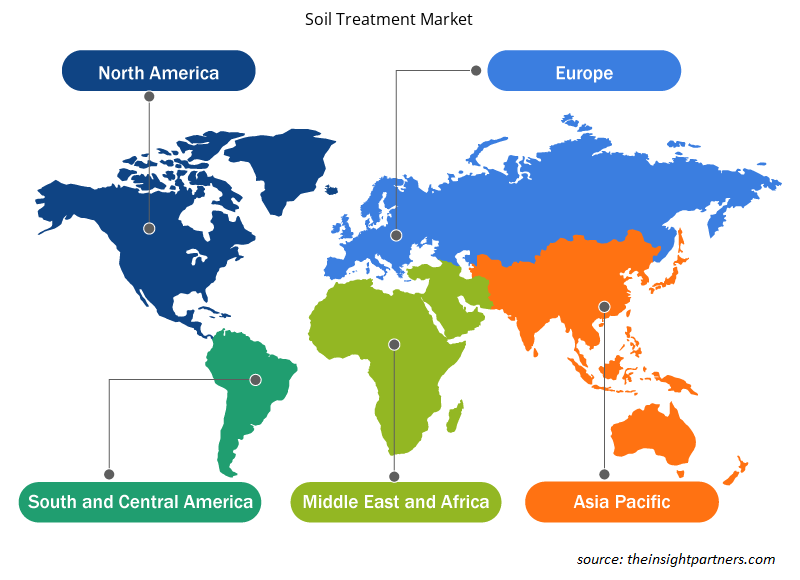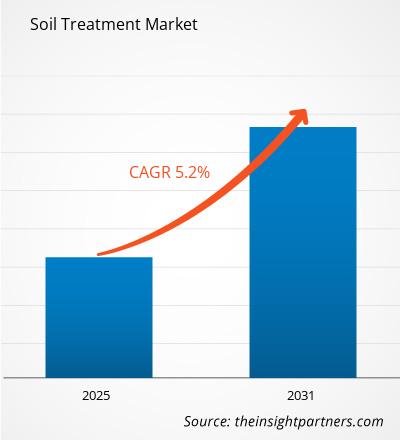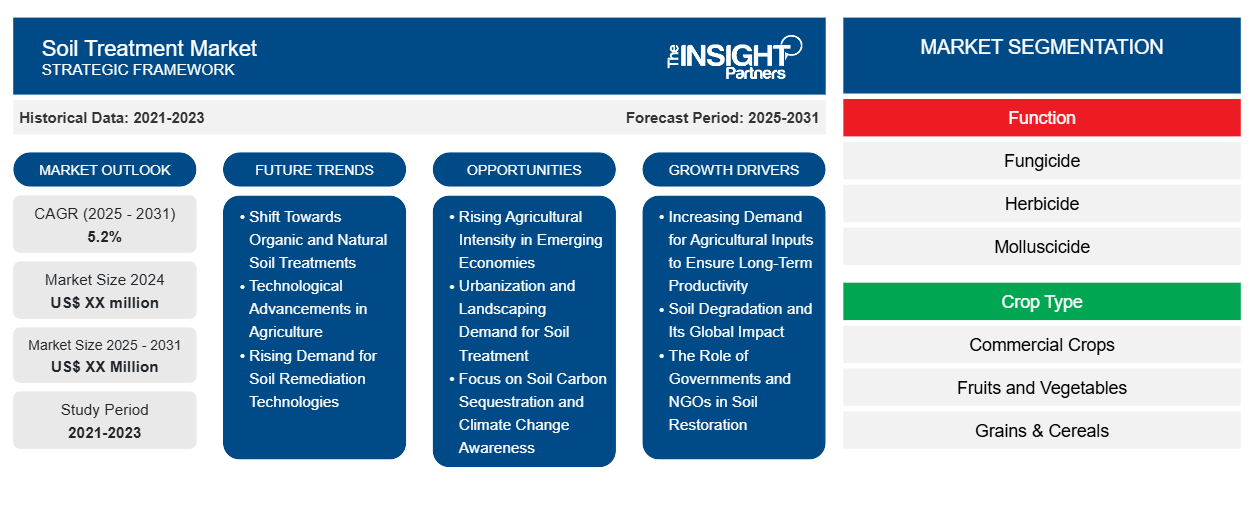من المتوقع أن يسجل سوق معالجة التربة معدل نمو سنوي مركب بنسبة 5.2٪ من عام 2024 إلى عام 2031، مع توسع حجم السوق من XX مليون دولار أمريكي في عام 2024 إلى XX مليون دولار أمريكي بحلول عام 2031.
تم تقسيم التقرير حسب الوظيفة (مبيدات الفطريات، ومبيدات الأعشاب، ومبيدات الرخويات، ومبيدات الحشرات، ومبيدات النيماتودا). كما يقدم التقرير تحليلاً يعتمد على نوع المحصول (المحاصيل التجارية، والفواكه والخضروات، والحبوب، والبقوليات والبذور الزيتية، والعشب والنباتات الزينة). ويغطي نطاق التقرير خمس مناطق: أمريكا الشمالية، وأوروبا، وآسيا والمحيط الهادئ، والشرق الأوسط وأفريقيا، وأمريكا الجنوبية والوسطى، والدول الرئيسية في كل منطقة. كما تم تقسيم التحليل العالمي على المستوى الإقليمي والدول الرئيسية. ويقدم التقرير القيمة بالدولار الأمريكي للتحليل والشرائح المذكورة أعلاه.
غرض التقرير
يهدف تقرير سوق معالجة التربة الصادر عن The Insight Partners إلى وصف المشهد الحالي والنمو المستقبلي وأهم العوامل الدافعة والتحديات والفرص. وسيوفر هذا رؤى لمختلف أصحاب المصلحة في الأعمال التجارية، مثل:
- مزودي/مصنعي التكنولوجيا: لفهم ديناميكيات السوق المتطورة ومعرفة فرص النمو المحتملة، وتمكينهم من اتخاذ قرارات استراتيجية مستنيرة.
- المستثمرون: إجراء تحليل شامل للاتجاهات فيما يتعلق بمعدل نمو السوق، وتوقعات السوق المالية، والفرص المتاحة عبر سلسلة القيمة.
- الهيئات التنظيمية: لتنظيم السياسات ومراقبة الأنشطة في السوق بهدف تقليل الانتهاكات والحفاظ على ثقة المستثمرين والحفاظ على سلامة السوق واستقرارها.
تجزئة سوق معالجة التربة
وظيفة
- مبيد الفطريات
- مبيد الأعشاب
- مبيد الرخويات
- مبيد حشري
- مبيد النيماتودا
نوع المحصول
- المحاصيل التجارية
- الفواكه والخضروات
- الحبوب والبذور
- البقوليات والبذور الزيتية
- العشب والزينة
قم بتخصيص هذا التقرير ليناسب متطلباتك
ستحصل على تخصيص لأي تقرير - مجانًا - بما في ذلك أجزاء من هذا التقرير، أو تحليل على مستوى الدولة، وحزمة بيانات Excel، بالإضافة إلى الاستفادة من العروض والخصومات الرائعة للشركات الناشئة والجامعات
- احصل على أهم اتجاهات السوق الرئيسية لهذا التقرير.ستتضمن هذه العينة المجانية تحليلاً للبيانات، بدءًا من اتجاهات السوق وحتى التقديرات والتوقعات.
عوامل نمو سوق معالجة التربة
- الطلب المتزايد على المدخلات الزراعية لضمان الإنتاجية على المدى الطويل: مع تزايد عدد سكان العالم، فإن الحاجة إلى المنتجات الزراعية تتطلب مدخلات أعلى في التربة للمعالجة المناسبة لضمان الإنتاجية الزراعية على المدى الطويل وتوافر إنتاج غذائي مستدام. يعد التسميد وتعديل درجة الحموضة والتعديلات العضوية المستخدمة في معالجة التربة أمرًا بالغ الأهمية لأنها تؤثر على صحة التربة وتعظيم إنتاج المحاصيل وضمان الإنتاجية الزراعية على المدى الطويل وتعزيز الإنتاج. يتطلب الإنتاج الزراعي المرتفع حلاً أكثر كفاءة لمعالجته.
- تدهور التربة وتأثيره العالمي: إن الإفراط في استخدام الأراضي الزراعية، وإزالة الغابات، والتصنيع، والاحتباس الحراري المرتبط بتدهور التربة يهدد العالم. وتشمل التحديات الرئيسية التي تواجهنا في هذا الجانب تآكل التربة، واستنزاف المغذيات، والتلوث. وقد استدعى هذا تبني تحسين التربة، والسيطرة على تآكل التربة، وإصلاحها، وبالتالي زيادة استعادة التربة الصحية والحفاظ عليها. والحكومات والمنظمات غير الحكومية والصناعات المرتبطة بالأعمال الزراعية لديها مصلحة في التعامل مع التربة كوسيلة لعكس الآثار السيئة المتراكمة الناجمة عن سوء إدارة التربة.
- دور الحكومات والمنظمات غير الحكومية في استعادة التربة: إن زيادة الوعي بالعوامل البيئية واللوائح الحكومية الصارمة فيما يتعلق بمعالجة التربة بمنتجات الزراعة المستدامة تدفع إلى تبني منتجات معالجة التربة. تعد المعالجات العضوية والصديقة للبيئة، كونها صديقة للبيئة، من أفضل الخيارات للمزارعين حيث يميل العملاء إلى استخدام الحد الأدنى من المواد الكيميائية في الزراعة وتجنب تلوث التربة والمياه. تتطلب اللوائح الزراعية معالجة التربة لتبني المبادئ الزراعية الصارمة للزراعة الآمنة والصحية.
الاتجاهات المستقبلية لسوق معالجة التربة
- التحول نحو معالجات التربة العضوية والطبيعية: تتزايد المعالجات العضوية والطبيعية للتربة مثل السماد العضوي والفحم الحيوي والأسمدة النباتية. وذلك لأن المستهلكين يفضلون المنتجات العضوية وتفرض اللوائح البيئية الأكثر صرامة إدارة التربة غير السامة والمستدامة. كما تنمو معالجات التربة القائمة على المواد البيولوجية بسبب كونها صديقة للبيئة وآمنة أكثر من المنتجات الكيميائية الاصطناعية.
- التطورات التكنولوجية في الزراعة: تعمل التكنولوجيا الجديدة واعتمادها في الزراعة على تغيير طريقة معالجة التربة. تهيمن تحليلات البيانات وأجهزة إنترنت الأشياء والطائرات بدون طيار وأجهزة الاستشعار الأخرى على القدرة على الانخراط في الزراعة الدقيقة. كما يتم إجراء مراقبة في الوقت المناسب لظروف التربة بمساعدة المعالجات المستهدفة. تضمن هذه التقنيات عدم إهدار أسمدة التربة من خلال تقليل النفايات إلى أدنى حد وكذلك تحقيق الكفاءة العامة المثلى في التطبيقات التي يتم إجراؤها في معالجة التربة. من المرجح أن يؤدي استخدام التكنولوجيا الأكثر سهولة في الوصول إلى تصعيد مشاركة هذه التكنولوجيا في سوق معالجة التربة.
- الطلب المتزايد على تقنيات معالجة التربة: ينشأ الطلب المتزايد على تقنيات معالجة التربة عن تلوث التربة بالمعادن الثقيلة والمبيدات الحشرية والنفايات الصناعية وغيرها من الملوثات. وقد بدأ الطلب المتزايد بشكل مطرد على تقنيات المعالجة الخضراء مثل المعالجة البيولوجية والمعالجة النباتية لإزالة التلوث وإحياء التربة الملوثة في إظهار قوة السوق. وتتمثل القوى الدافعة الرئيسية وراء هذا الاتجاه في تحسن الوعي البيئي والتشريعات الجديدة المتعلقة بالتلوث الصناعي وضرورة وجود أرض نظيفة وصحية للزراعة والاحتياجات الحضرية.
فرص سوق معالجة التربة
- إن تزايد كثافة الزراعة في الاقتصادات الناشئة، وخاصة في منطقة آسيا والمحيط الهادئ وأميركا اللاتينية وأفريقيا، من شأنه أن يؤدي إلى توسيع الطلب على تقنيات معالجة التربة. والواقع أن القضايا التي تبتلي هذه الاقتصادات الناشئة ــ ممارسات إدارة التربة الرديئة والإفراط في الزراعة في العديد من أجزاء هذه الاقتصادات ــ تشكل فرصاً للشركات العاملة في مجال تقنيات معالجة التربة مثل التعديلات العضوية، والتحكم في درجة الحموضة، واستعادة صحة التربة.
- الطلب على معالجة التربة في مشاريع تنسيق الحدائق: مع تزايد التوسع الحضري والتسويق، تزداد الحاجة إلى معالجة التربة في مشاريع تنسيق الحدائق بشكل مستمر. وقد أصبحت متطلبًا أساسيًا للمساعدة في نمو النباتات في الظروف الحضرية القاسية التي تتراوح من الحدائق الحضرية إلى الأسطح الخضراء والملاعب الرياضية. وتعتبر مواد تحسين التربة والأسمدة ومواد مكافحة التآكل ذات أهمية حيوية لرعاية المدن الصحية المستدامة. وهذا بدوره يصبح فرصة جديدة لتطوير السوق للشركات التي تعالج التربة.
- التركيز على احتجاز الكربون في التربة والتوعية بتغير المناخ: جنبًا إلى جنب مع الوعي المتزايد بتغير المناخ، فإن التركيز على احتجاز الكربون في التربة يتزايد ببطء ولكن بثبات. ومن بين هذه الأساليب كميات كبيرة من الفحم الحيوي والسماد والمحاصيل الغطائية، والتي يمكنها بالتالي تعزيز قدرة التربة على احتجاز الكربون وتخزينه. وتكتسب مثل هذه الأساليب اعترافًا كجزء من مبادرات زراعة الكربون الأكبر حجمًا والتي تفتح آفاقًا جديدة للشركات التي تطور معالجات التربة التي تدعم جهود احتجاز الكربون.
رؤى إقليمية حول سوق معالجة التربة
لقد قام المحللون في Insight Partners بشرح الاتجاهات والعوامل الإقليمية المؤثرة على سوق معالجة التربة طوال فترة التوقعات بشكل شامل. يناقش هذا القسم أيضًا قطاعات سوق معالجة التربة والجغرافيا في جميع أنحاء أمريكا الشمالية وأوروبا ومنطقة آسيا والمحيط الهادئ والشرق الأوسط وأفريقيا وأمريكا الجنوبية والوسطى.

- احصل على البيانات الإقليمية المحددة لسوق معالجة التربة
نطاق تقرير سوق معالجة التربة
| سمة التقرير | تفاصيل |
|---|---|
| حجم السوق في عام 2024 | XX مليون دولار أمريكي |
| حجم السوق بحلول عام 2031 | XX مليون دولار أمريكي |
| معدل النمو السنوي المركب العالمي (2025 - 2031) | 5.2% |
| البيانات التاريخية | 2021-2023 |
| فترة التنبؤ | 2025-2031 |
| القطاعات المغطاة | حسب الوظيفة
|
| المناطق والدول المغطاة | أمريكا الشمالية
|
| قادة السوق وملفات تعريف الشركات الرئيسية |
|
كثافة اللاعبين في سوق معالجة التربة: فهم تأثيرها على ديناميكيات الأعمال
يشهد سوق معالجة التربة نموًا سريعًا، مدفوعًا بالطلب المتزايد من المستخدم النهائي بسبب عوامل مثل تفضيلات المستهلك المتطورة والتقدم التكنولوجي والوعي المتزايد بفوائد المنتج. ومع ارتفاع الطلب، تعمل الشركات على توسيع عروضها والابتكار لتلبية احتياجات المستهلكين والاستفادة من الاتجاهات الناشئة، مما يؤدي إلى زيادة نمو السوق.
تشير كثافة اللاعبين في السوق إلى توزيع الشركات أو المؤسسات العاملة في سوق أو صناعة معينة. وهي تشير إلى عدد المنافسين (اللاعبين في السوق) الموجودين في مساحة سوق معينة نسبة إلى حجمها أو قيمتها السوقية الإجمالية.
الشركات الرئيسية العاملة في سوق معالجة التربة هي:
- شركة ADAMA للحلول الزراعية المحدودة
- شركة فانغارد الأمريكية
- شركة أركيما السعودية
- باسف اس اي
- معالجة التربة كانيشو
إخلاء المسؤولية : الشركات المذكورة أعلاه ليست مرتبة بأي ترتيب معين.

- احصل على نظرة عامة على أهم اللاعبين الرئيسيين في سوق معالجة التربة
نقاط البيع الرئيسية
- التغطية الشاملة: يغطي التقرير بشكل شامل تحليل المنتجات والخدمات والأنواع والمستخدمين النهائيين لسوق معالجة التربة، مما يوفر صورة شاملة.
- تحليل الخبراء: تم تجميع التقرير على أساس الفهم العميق لخبراء الصناعة والمحللين.
- معلومات محدثة: يضمن التقرير أهمية الأعمال التجارية بسبب تغطيته للمعلومات الحديثة واتجاهات البيانات.
- خيارات التخصيص: يمكن تخصيص هذا التقرير لتلبية متطلبات العملاء المحددة وبما يتناسب مع استراتيجيات العمل بشكل مناسب.
وبالتالي، فإن تقرير البحث حول سوق معالجة التربة يمكن أن يساعد في تمهيد الطريق لفك شفرة وفهم سيناريو الصناعة وآفاق النمو. ورغم وجود بعض المخاوف المشروعة، فإن الفوائد الإجمالية لهذا التقرير تميل إلى التفوق على العيوب.
- التحليل التاريخي (سنتان)، سنة الأساس، التوقعات (7 سنوات) مع معدل النمو السنوي المركب
- تحليل PEST و SWOT
- حجم السوق والقيمة / الحجم - عالمي، إقليمي، بلد
- الصناعة والمنافسة
- مجموعة بيانات إكسل
التقارير الحديثة
تقارير ذات صلة
شهادات العملاء
سبب الشراء
- اتخاذ قرارات مدروسة
- فهم ديناميكيات السوق
- تحليل المنافسة
- رؤى العملاء
- توقعات السوق
- تخفيف المخاطر
- التخطيط الاستراتيجي
- مبررات الاستثمار
- تحديد الأسواق الناشئة
- تحسين استراتيجيات التسويق
- تعزيز الكفاءة التشغيلية
- مواكبة التوجهات التنظيمية





















 احصل على عينة مجانية ل - سوق معالجة التربة
احصل على عينة مجانية ل - سوق معالجة التربة